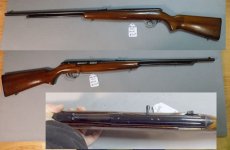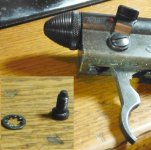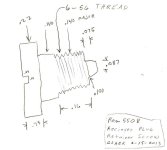Back to this rifle. On Friday, I finally got it to the range for some testing of the 550-1, along with my also fairly recently purchased Remington Nylon 10C (like the Nylon 66 but with a detachable 10 round box magazine). I set up A-36 targets (12 bulls per target) at 25 yards and all firing was done from a solid bench rest over sandbags. Both rifles had 1" 4X scopes, a Weaver K4 on the 550-1 and a Bushnell on the 10C. 10 shot groups were fired, as 5 shot groups are nearly worthless for testing grouping capability with any statistical confidence. For this experiment, I fired 5 groups each of Federal bulk pack .22 LR 36 grain HPs and also Aguila 40 grain Standard Velocity LR solids from each rifle.
Remington 550-1: Average ES of five 10-shot groups
Federal - 1.46"
Aguila SV - 0.97"
Additionally, I fired a single 10-shot group using some old Western Super Match .22 short from the late 1950s. It produced a 0.58" group, without malfunctions. I also fired a single 10-shot group using mixed .22 LR rounds from Federal, Winchester, Remington, and CCI. That produced a group ES of 2.05".
Remington Nylon 10C: Average ES of five 10-shot groups
Federal - 1.33"
Aguila SV - 0.94"
As the Nylon 10C will not feed .22 shorts, I did not fire a check group using them in that rifle.
I suppose it can be concluded that both rifles shoot better with the Aguila SV ammunition. And that the 550-1 shoots best with the .22 Short loads.
------------------------------------------
Just as a matter of interest for those misguided souls who are more used to firing 5-shot groups to judge performance, the approximate conversion of 10-shot group ES to 5-shot group ES involves multiplying the average 10 shot ES by 0.81. i.e., all other things (gun, ammunition, shooter, distance) being equal, an average 10-shot group ES will be about 25% greater than an average 5-shot group ES. There is sound mathematical reasoning behind this which I will not go into.




